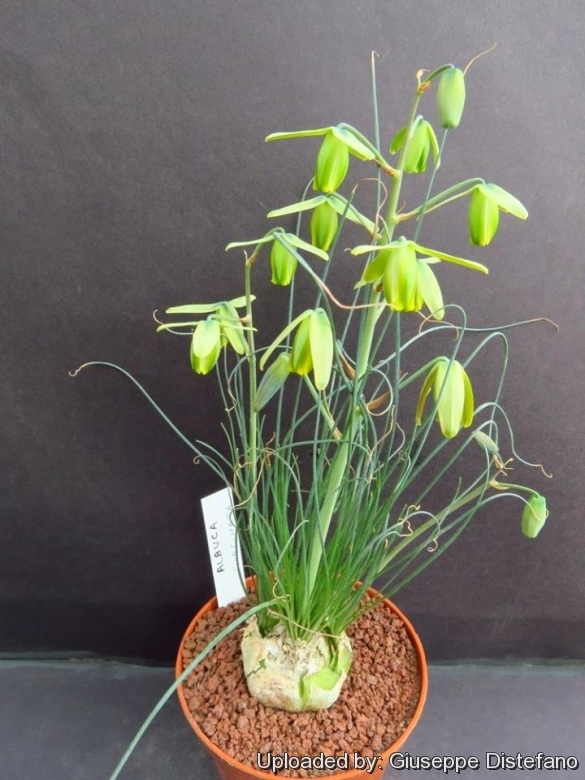Accepted Scientific Name: Albuca namaquensis Baker
Fl. Cap. (Harvey) 6: 456 (1897). Harv.

Albuca circinata Photo by: Giuseppe Distefano
Origin and Habitat: Eastern Cape, South Africa.
Habitat ad ecology: Albuca circinataSN|34243]]SN|34243]] grows in sandy soil along the coast in Southern suburbs of Port Elizabeth to Sardinia Bay Nature Reserve. Flowering November-March.
Synonyms:
See all synonyms of Albuca namaquensis
back
Accepted name in llifle Database:Albuca namaquensis BakerFl. Cap. (Harvey) 6: 456 (1897).Synonymy: 7
back
Common Names include:
ENGLISH: coastal albuca
Description: Albuca circinataSN|34243]]SN|34243]] (Coastal albuca) is one of the local or morphological form of Albuca namaquensisSN|34241]]SN|34241]] that shows a wide range of natural variability. Albuca circinataSN|34243]]SN|34243]] grows from bulbs, and has a dormancy period after flowering whereby it lose its leaves. The flower scape is unbranched up to 350 mm long. The graceful flowers are nodding or pendulous in shades of green and pale mustard, they are very effective and worth grow.
Bulb: Globose, sitting partially on top of the ground and cluster-forming, tunics white membranous.
Leaves: Several, grass like, arising from the bulb, 15-23 cm long, 2 mm on diameter erect, glabrous nearly straight to very curly with coiled tip (The degree of spiral depends on the clone and the amount of sunlight the plant receives when the leaves started growing).
Inflorescence (raceme): Peduncle hairless enlarged near the base up to 35 cm tall. Raceme dense few flowered, pedicels erect to reclined 12-18 mm long, bracts ovate, pointed. Perianth campanulate 12-16 mm long. Outer tepals ochre with olive-green keels, inner tepals oblong bright yellow to dull yellow green with green keels. All the stamens bearing anthers. Style prismatic about as long as the ovary. Smells pleasant.
Subspecies, varieties, forms and cultivars of plants belonging to the Albuca namaquensis group
 Albuca circinata Baker: has scape up to 350 mm long with graceful nodding or pendulous flowers in shades of green and pale mustard. Distribution: coastal regions of Eastern Cape, South Africa.
Albuca circinata Baker: has scape up to 350 mm long with graceful nodding or pendulous flowers in shades of green and pale mustard. Distribution: coastal regions of Eastern Cape, South Africa. - Albuca namaquensis Baker
Bibliography: Major references and further lectures
1) Helen J. Vanderplank “Wildflowers of the Port Elizabeth Area: Gamtoos to Swartkops Rivers (the Coastal Bush and Fynbos Region)” Bluecliff, 1999
2) Una Van der Spuy “Wild Flowers of South Africa for the Garden” H. Keartland, 1971
3) Johann Leopold Just, Emil Koehne, Karl Schumann, Hermann Theodor Geyler, Friedrich Karl Georg Fedde “Just's botanischer Jahresbericht: Systematisch geordnetes Repertoriumder botanischen Literatur aller Länder”, Volume 33,Parte 2 Gebr. Borntraeger., 1907
4) “Feddes repertorium specierum novarum regni vegetabilis”, Volumi 1-2 Akademie Verlag, 1906
Cultivation and Propagation: Albuca circinataSN|34243]]SN|34243]] comes from the winter rainfall regions of south-western Africa, producing its miniature whirlwinds of leaves in early winter. The leaves usually curl better if given good light. It would probably look even better in a hot dry environment. It is one of the most difficult members to cultivate successfully over an extended period. It is a winter-growing and summer-dormant species that needs to be kept almost dry during its dormancy as the bulbs is disposed to dwindle and rot. Its summer rest must be absolute and does not initiate new foliage until the cooling effects of autumn. This plant may or may not have foliage in the heat of the summer. If it does have foliage, during the hottest part of summer, the foliage and plant may look ratty but as long as the bulb is firm the plant is in good health and it will improve in appearance once new foliage initiates in the autumn. A great plant for the southern rock garden as well.
Exposure: Prefers some direct sun but will scorch in hot, sunny, dry locations.
Waterings: Water sparingly when growing and a little care, it is a definite water-wise species. The curling of the leaf tips is largely dependent on weather conditions. Cool dry conditions encourage the leaf tips to curl, while warm most conditions tends to encourage erect, straight, uncurled leaf tips. When flowers begin to appear, water should be withheld in order to avoid rot. If the plants are allowed to dry too much, they will go dormant.
Soil: Coarse river sand or gravel must be incorporated into the growing medium for excellent drainage. It is often suggested to add gravel mulch on the top of the soil, so when the bulbs are dormant the pot remains interesting to view.
Hardiness: In the winter plants can be left outside because the spirally foliage is reliably hardy to – 7° C. In colder areas the plants should be protected in the greenhouse.
Propagation: Division, seeds. Seed germinate easily. It is best to propagate seeds in the autumn through winter in a mixture of moist peat and perlite. Cover the pot and plant with a plastic bag secured by a rubber band to prevent the moisture from escaping. Place in indirect sunlight or under a fluorescent light. Repot in its regular mix after it has been growing for a while. After dividing plant or removing offsets, pot it in its regular potting mix.










